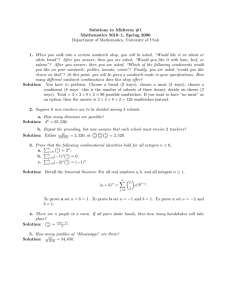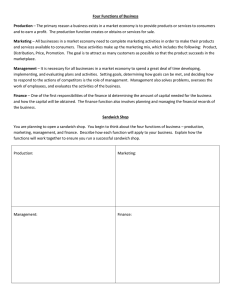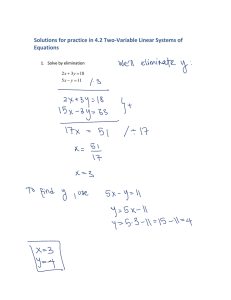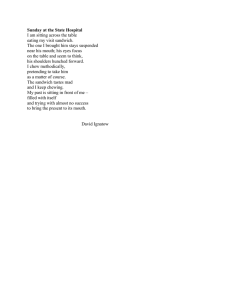Why Demand Curves are Downward Sloping and
advertisement
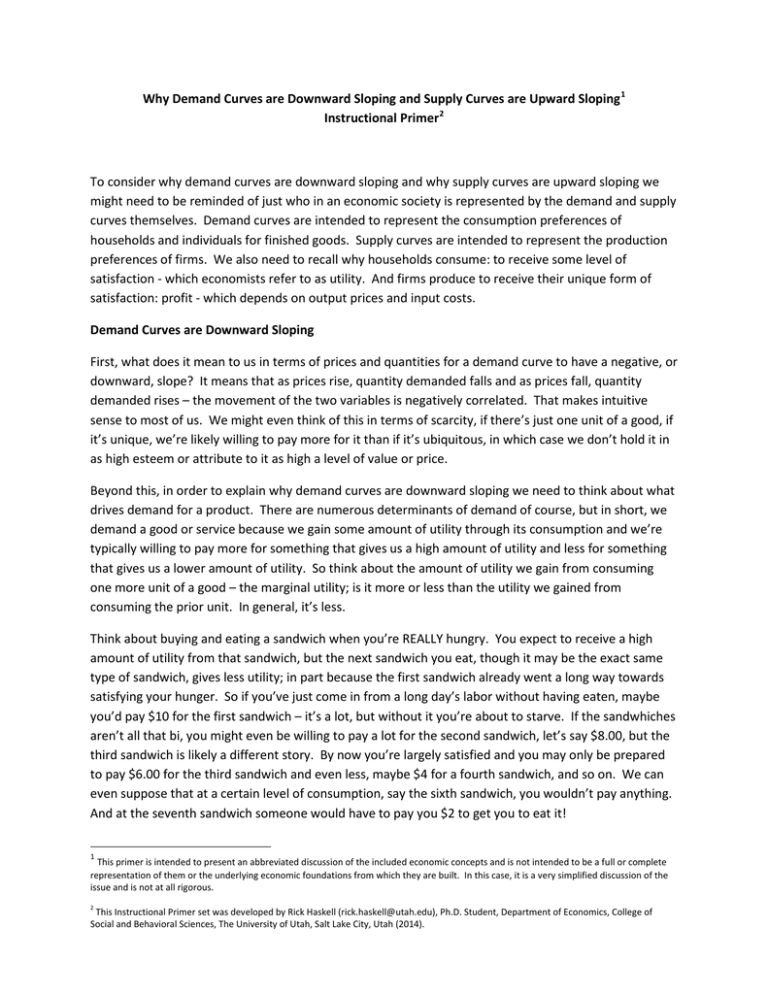
Why Demand Curves are Downward Sloping and Supply Curves are Upward Sloping 1 Instructional Primer 2 To consider why demand curves are downward sloping and why supply curves are upward sloping we might need to be reminded of just who in an economic society is represented by the demand and supply curves themselves. Demand curves are intended to represent the consumption preferences of households and individuals for finished goods. Supply curves are intended to represent the production preferences of firms. We also need to recall why households consume: to receive some level of satisfaction - which economists refer to as utility. And firms produce to receive their unique form of satisfaction: profit - which depends on output prices and input costs. Demand Curves are Downward Sloping First, what does it mean to us in terms of prices and quantities for a demand curve to have a negative, or downward, slope? It means that as prices rise, quantity demanded falls and as prices fall, quantity demanded rises – the movement of the two variables is negatively correlated. That makes intuitive sense to most of us. We might even think of this in terms of scarcity, if there’s just one unit of a good, if it’s unique, we’re likely willing to pay more for it than if it’s ubiquitous, in which case we don’t hold it in as high esteem or attribute to it as high a level of value or price. Beyond this, in order to explain why demand curves are downward sloping we need to think about what drives demand for a product. There are numerous determinants of demand of course, but in short, we demand a good or service because we gain some amount of utility through its consumption and we’re typically willing to pay more for something that gives us a high amount of utility and less for something that gives us a lower amount of utility. So think about the amount of utility we gain from consuming one more unit of a good – the marginal utility; is it more or less than the utility we gained from consuming the prior unit. In general, it’s less. Think about buying and eating a sandwich when you’re REALLY hungry. You expect to receive a high amount of utility from that sandwich, but the next sandwich you eat, though it may be the exact same type of sandwich, gives less utility; in part because the first sandwich already went a long way towards satisfying your hunger. So if you’ve just come in from a long day’s labor without having eaten, maybe you’d pay $10 for the first sandwich – it’s a lot, but without it you’re about to starve. If the sandwhiches aren’t all that bi, you might even be willing to pay a lot for the second sandwich, let’s say $8.00, but the third sandwich is likely a different story. By now you’re largely satisfied and you may only be prepared to pay $6.00 for the third sandwich and even less, maybe $4 for a fourth sandwich, and so on. We can even suppose that at a certain level of consumption, say the sixth sandwich, you wouldn’t pay anything. And at the seventh sandwich someone would have to pay you $2 to get you to eat it! 1 This primer is intended to present an abbreviated discussion of the included economic concepts and is not intended to be a full or complete representation of them or the underlying economic foundations from which they are built. In this case, it is a very simplified discussion of the issue and is not at all rigorous. 2 This Instructional Primer set was developed by Rick Haskell (rick.haskell@utah.edu), Ph.D. Student, Department of Economics, College of Social and Behavioral Sciences, The University of Utah, Salt Lake City, Utah (2014). What we’ve just described is the law of diminishing marginal utility, virtually synonymous with the law of diminishing marginal returns and similar to the law of diminishing marginal productivity. We also just defined a table suggesting what you might pay for various quantities of a good and that table can be used to form the demand curve for the good. Market for Sandwiches 15.00 Price Quantity Price 1 10.00 2 8.00 3 6.00 4 4.00 5 2.00 6 0.00 10.00 5.00 Demand 0.00 1 2 3 4 5 6 Quantity So, in this formation we see why the demand curve for an income-normal good, like a sandwich, would be expected to be downward sloping. It’s all about diminishing marginal utility and our willingness to pay for that utility. Obviously, we’re not offering a rigorous mathematical proof here; we’re just discussing this in very simplistic terms. Why Supply Curves are Upward Sloping What does it mean for a curve to be upward sloping or to have a positive slope? It means that as the price rises, the quantity also rises, and vice versa. We might think of this in terms of motivation: if you want someone to put in the extra effort required to produce more goods, you might need to pay them more per unit. That’s pretty simplistic and doesn’t really get at the underlying issue of the firm seeking greater utility, or profit, but it’s not altogether irrelevant. We need to return to the law of diminishing marginal returns or in this particular case, the law of diminishing marginal productivity. This law suggests that as we employ more units of any particular factor (input) of production, the productivity of that factor declines. The example I like to use is a very small sandwich shop in which I’m the owner, sandwich maker, order taker, server and cashier – all in one. In this set of roles I might be able to produce 15 sandwiches an hour. If I add an employee to assist me, and that person only makes sandwiches, then I think we can suppose the person’s productivity should be greater than my own – maybe they can make 20 sandwiches per hour – but this presumes that the size of my sandwich shop can accommodate another worker. Which is to say, that before adding the worker I was underutilizing the capital investment represented by the sandwich shop itself. So, as a business owner, I like the added production. If I pay the worker the same wage I pay myself, say $10 per hour, then the per unit wage cost just went down from $.66 per sandwich ($10/15 sandwiches) to $.57 [($10 + $10)/(15 + 20 sandwiches)]. If I then add another worker expecting that I’d see a similar increase in productivity (and decrease in per unit cost), I might be surprised. Remember that I said I had a very small sandwich shop, in fact it’s really just big enough to accommodate 2 workers without getting into each other’s way, but I don’t really know that until I add that additional worker. So I add the 3rd worker and find that this person only contributes another 15 sandwiches per hour, and I add yet another and find that the 4th worker only adds another 10 sandwiches per and the 5th worker actually decreases overall production by 5 sandwiches per hour. What we’ve done is created a demand curve for labor as an input to production, but I’ve also shown that as the quantity of output rises, the cost of producing the good also rises; once we’re fully utilized our capital. Wage Labor Quantity Cost per unit 10 10 10 10 10 1 2 3 4 5 15 35 50 60 55 0.67 0.57 0.60 0.67 0.91 So unless the producer is prepared to accept less profit per unit, which would be the result of increasing input costs with a stable price per unit for the finished good, then prices will have to rise. In this case, we see that the cost of producing a sandwich begins to increase from $.57 to $.91 and we can suppose that the cost of other inputs to production might also rise such that a producer might have to consider the following table for prices and quantities of sandwich production: Price 3 4 5 6 7 8 9 10 Market for Sandwiches Price Quantity 10 20 30 40 50 60 70 80 12 10 8 6 4 2 0 Supply 10 20 30 40 50 Quantity Which is why supply curves must be upward sloping. 60 70 80 Supply and Demand together If we now try to put this market together in one graph so we can see both supply and demand, we’d first have to aggregate the quantity and price preferences of the lone consumer in the demand discussion so that it approximately the demand for an entire market. We’ll do this by forming a new table showing both Quantity Demanded and Quantity Supplied aside given price levels: Price Market for Sandwiches 90 80 70 60 50 40 30 20 10 0 Supply Demand 1 2 3 4 5 Quantity 6 7 8 Price 3 4 5 6 7 8 9 10 Quantity Demanded 80 70 60 50 40 30 20 10 Quantity Supplied 10 20 30 40 50 60 70 80 What we can now see is that at a point, supply equals demand: we call this the market clearing point or equilibrium, which is the subject of an entirely different, and somewhat more rigorous, discussion.
